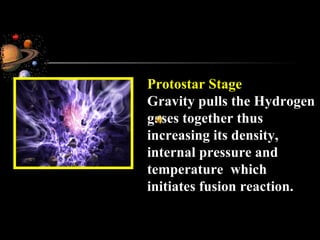Stars
- 1. LETŌĆÖS EXPLORE OUR UNIVERSE!
- 2. STARS
- 3. Q UESTIONS What is it about stars that made them the object of manŌĆÖs fascination? What roles do they play in our lives? How much do we really know about them?
- 4. ŌĆ£ Ancient civilizations searched the heavens in wonder and awe.ŌĆØ ZIGURRAT PYRAMIDS STONEHENGE
- 5. ŌĆ£ Watching the movement of the sun, moon and stars became a way to identify cycles for crop planting & harvesting, celebrating events and marking the passage of time and seasons.ŌĆØ CROP PLANTING HARVEST
- 6. ŌĆ£ And yet for some, it became a way of worship and seeking their unknown gods.ŌĆØ STARS, SUN AND MOON WORSHIP ASTROLOGY
- 7. ŌĆ£ But then again, we know far better to worship not the creation but the Creator!ŌĆØ 1 ŌĆ£In the beginning God created the heavens and the earth... 3 And God said, ŌĆ£Let there be light.ŌĆØ 4 God saw that the light was good, and He separated the light from darkness. 5a God called the light ŌĆ£dayŌĆØ and the darkness He called ŌĆ£nightŌĆØ ŌĆ” 14 And God said, ŌĆ£Let there be lights in the expanse of the sky to separate the day from the night, and let them serve as signs to mark seasons and days and years, 15 and let them be lights in the expanse of the sky to give light to the earth.ŌĆØ And it was so. 16 God made two great lights ŌĆō the greater light to govern the day and the lesser light to govern the night. He also made the stars. 17 God set them in the expanse of the sky to give light on earth, 18 to govern the day and night and to separate light from darkness. And God saw that it was good.ŌĆØ GENESIS 1: 1,3-5a,14-18
- 8. Q UESTIONS How are stars formed? How are they classified? What are the stages in the life of a star?
- 9. ORIGIN OF THE STARS
- 10. Stars originate from swirling clouds of gas in deep space located between other stars called the nebulae
- 11. Mutual gravitational attraction begins to pull particles from the gases into a cluster. The cloud of gas begins to condense eventually forming a dense sphere called, protostar which a has an average diameter of 2.5 million kilometers.
- 12. Pressure and energy from hot gases due to the increasing fusion reaction begins to balance the gravitational attraction of each particle and a newborn average star begins its stable life.
- 13. Core ŌĆō a dense, gaseous and very hot region where radioactivity take place. Structure of an Average Star Radiation zone Core Convection zone Radiation zone ŌĆō the region where energy in the form of radioactive particles is absorbed and reemitted. Convection zone ŌĆō the region where gases that are heated by the radiation zone rises to the surface and emit energy in the form of visible light, ultraviolet and infrared radiation which moves out into space.
- 15. ACCORDING TO BRIGHTNESS AND TEMPERATURE Factors that Affect the Brightness of Stars 1. The amount of light produced by the star 2. The size of the star 3. The relative distance of the star
- 16. STAR TYPES AND THEIR TEMPERATURE 2 000 ŌĆō 3 500 Reddish M 3 500 ŌĆō 5 000 Red orange K 5 000 ŌĆō 6 000 Yellow G 6 000 ŌĆō 7 500 White F 7 500 ŌĆō 10 000 Bluish A 10 000 ŌĆō 30 000 Bluish B 30 000 ŌĆō 80 000 Bluish O Temperature (in K) Color Type
- 17. STAGES IN THE LIFE OF A STAR (STAR CYCLE)
- 18. Protostar Stage Gravity pulls the Hydrogen gases together thus increasing its density, internal pressure and temperature which initiates fusion reaction.
- 19. Main Sequence Stage Star grows more massive and with increased surface temperature. It uses up its Hydrogen fuel as it shines brighter
- 20. Red Giant Stage Fewer Hydrogen fusion reactions, less energy is released and the star starts to collapse. Its outer layers begin to expand, increasing its surface area. Amount of radiation decreases and it acquires the properties of a brilliant red giant. What follows depend on how massive the star isŌĆ”
- 21. The core of the Red giant is gradually converted into Carbon. The star expands and contract and the outer layer gets blown-off forming planetary nebulae . The remaining Carbon core contracts to form a small, dense white dwarf star until it finally cools into a lump of Carbon in space. *The Final Stage of a Less Massive Star
- 22. The core of the Red giant is gradually converted into Carbon. The star expands and contract and the outer layer gets blown-off. The remaining Carbon core undergoes fusion reaction producing new elements until the stable atom of Iron is reached. The core collapses from intense heat and pressure due to its massive gravity. It explodes catastrophically forming a supernova. **The Final Stages of a Massive Star (Supernova Stage)
- 23. END OF A SUPERNOVA Neutron Star Stage The supernova produces a brilliant light that may last for months before it begins to dim. Iron core collapses even further and evolves into heavier elements thus, forming what is called a neutron star .
- 24. Pulsar Stage A neutron star starts to emit a uniform series of electromagnetic impulses which emit visible light that sweeps through space at regular intervals.
- 25. Black Hole Stage The force of gravity in the core reaches its limits causing it to finally collapse. It becomes very, very dense that even light cannot escape through it.
- 26. SUMMARY OF A STARŌĆÖS LIFE CYCLE
- 27. ╠²
- 28. ╠²



























